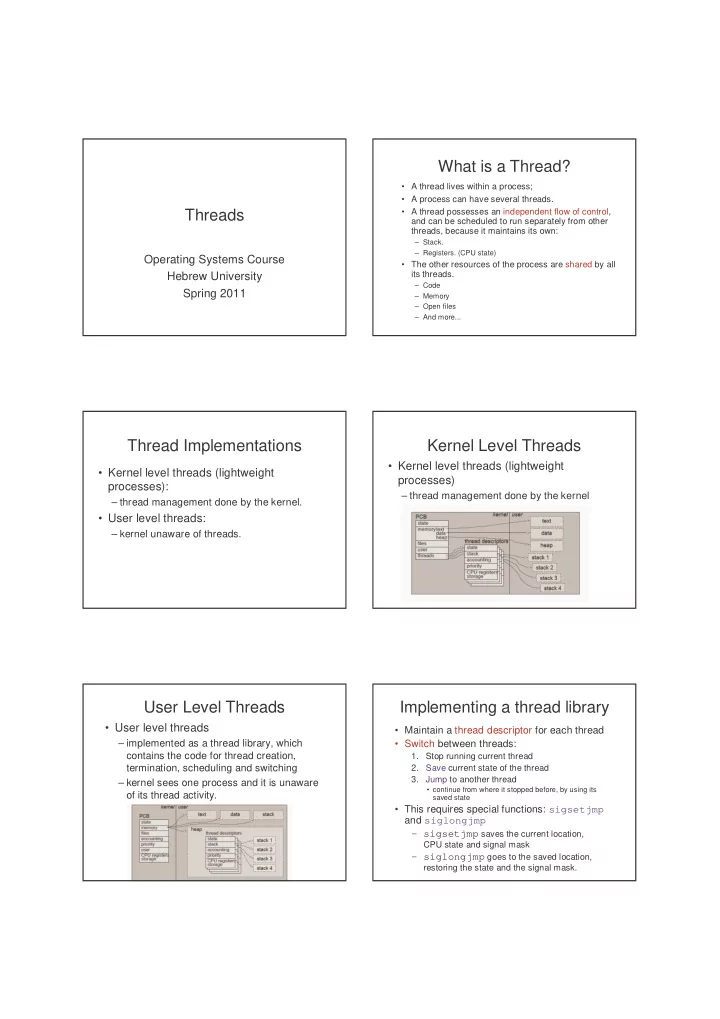

What is a Thread? • A thread lives within a process; • A process can have several threads. • A thread possesses an independent flow of control, Threads and can be scheduled to run separately from other threads, because it maintains its own: – Stack. – Registers. (CPU state) Operating Systems Course • The other resources of the process are shared by all its threads. Hebrew University – Code Spring 2011 – Memory – Open files – And more... Thread Implementations Kernel Level Threads • Kernel level threads (lightweight • Kernel level threads (lightweight processes) processes): – thread management done by the kernel – thread management done by the kernel. • User level threads: – kernel unaware of threads. User Level Threads Implementing a thread library • User level threads • Maintain a thread descriptor for each thread – implemented as a thread library, which • Switch between threads: contains the code for thread creation, 1. Stop running current thread termination, scheduling and switching 2. Save current state of the thread 3. Jump to another thread – kernel sees one process and it is unaware • continue from where it stopped before, by using its of its thread activity. saved state • This requires special functions: sigsetjmp and siglongjmp – sigsetjmp saves the current location, CPU state and signal mask – siglongjmp goes to the saved location, restoring the state and the signal mask.
sigsetjmp – save a “bookmark” siglongjmp – use a “bookmark” sigsetjmp(sigjmp_buf env, int savesigs) siglongjmp(sigjmp_buf env, int val) • Jumps to the code location and restore CPU state • Saves the stack context and CPU state in specified by env env for later use. • The jump will take us into the location in the code • If savesigs is non-zero, saves the current where the sigsetjmp has been called. signal mask as well. • If the signal mask was saved in sigsetjmp , • We can later jump to this code location and it will be restored as well. state using siglongjmp . • The return value of sigsetjmp after arriving from siglongjmp , will be • Return value: the user-defined val . – 0 if returning directly. – A user-defined value if we have just arrived here using siglongjmp. Demo Code : the threads A Demo void f() • Functions f() and g() { int i=0; while(1) { – Each representing a different thread ++i; printf("in f (%d)\n",i); • switchThreads() if (i % 3 == 0) { printf("f: switching\n"); – A function that switches between the switchThreads(); threads using sigsetjmp and } usleep(SECOND); siglongjmp } } • main() void g() – Initialization and starting the threads. { ... //similar code } The switch Demo Code: the switch Thread 0: Thread 1: sigjmp_buf jbuf[2]; void switchThreads() void switchThreads() { { void switchThreads() static int curThread = 0; static int curThread = 0; { int ret_val = int ret_val = static int curThread = 0; sigsetjmp(jbuf[curThread],1); sigetjmp(jbuf[curThread],1); int ret_val = if (ret_val == 1) { if (ret_val == 1) { sigsetjmp(jbuf[curThread],1); return; return; printf("SWITCH: ret_val=%d\n", ret_val); } } curThread = if (ret_val == 1) { curThread = 1 - curThread; 1 - curThread; return; siglongjmp(jbuf[curTh],1); siglongjmp(jbuf[curThread],1); } } } curThread = 1 - curThread; siglongjmp(jbuf[curThread],1); }
Demo Code: initialization What is saved in jbuf ? char stack1[STACK_SIZE]; char stack2[STACK_SIZE]; • Program Counter typedef unsigned long address_t; //64bit address – Location in the code #define JB_SP 6 • Stack pointer #define JB_PC 7 – Locations of local variables void setup() { – Return address of called functions unsigned int sp, pc; sp = (address_t)stack1 + STACK_SIZE - sizeof(address_t); • Signal Mask – if specified pc = (address_t)f; • Rest of environmant (CPU state) sigsetjmp(jbuf[0],1); (jbuf[0]->__jmpbuf)[JB_SP] = translate_address(sp); – Calculations can continue from where they stopped. (jbuf[0]->__jmpbuf)[JB_PC] = translate_address(pc); sigemptyset(&jbuf[0]->__saved_mask);//empty saved signal mask • Not Saved: ... //the same for jbuf[1] with g } – Global variables int main() { – Variables allocated dynamically setup(); siglongjmp(jbuf[0],1); – Values of local variables return 0; – Any other global resources } Implement a user-threads library • The library should provide thread manipulation functions. – Init – Spawn Ex2 – Sleep – Sync – Terminate – Get pid • Library users can create their own threads and use the library functions to manipulate them. • The library is in charge of thread management and scheduling. The scheduler Thread State Diagram • The running thread is always the one with the highest id (i.e. the one created last) compared to all the ready threads. • If a running thread becomes suspended, the scheduler needs to decide which thread will run instead. • Use code demos for examples of – Thread switching, – Using timers and timer signals.
This exercise is difficult, so start early! Good Luck!
Recommend
More recommend